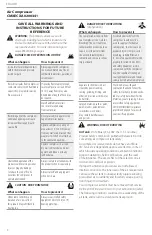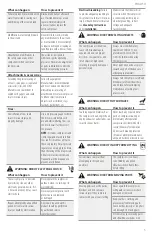
ENGLISH
On(I)/Off(O) Switch:
4
in the On(I)
position to provide automatic power to the pressure switch
Pressure Switch (not shown):
The pressure switch
automatically starts the motor when the air tank pressure
drops below the factory set “cut-in” pressure. It stops the
motor when the air tank pressure reaches the factory set
Safety Valve:
If the pressure switch does not shut off the
air compressor at its “cut-out” pressure setting, the safety
will protect against high pressure by “popping out”
at its factory set pressure (slightly higher than the pressure
Tank Pressure Gauge:
5
Outlet Pressure Gauge:
9
indicates the air pressure available at the outlet side of the
regulator. This pressure is controlled by the regulator and is
always less than or equal to the tank pressure.
Regulator:
Controls the air pressure shown on
7
clockwise to increase pressure and counterclockwise to
Cooling System (not shown):
This compressor contains
an advanced design cooling system. At the heart of this
cooling system is an engineered fan. It is perfectly normal
for this fan to blow air through the vent holes in large
amounts. You know that the cooling system is working
Air Compressor Pump (not shown):
Compresses air into
the air tank. Working air is not available until the compressor
has raised the air tank pressure above that required at the
Drain Valve:
10
is located at the base of
the air tank and is used to drain condensation at the end of
Check Valve (not shown):
When the air compressor is
operating, the check valve is “open”, allowing compressed
air to enter the air tank. When the air compressor reaches
“cut-out” pressure, the check valve “closes”, allowing air
Motor Overload Protector (not shown):
The motor has
a thermal overload protector. If the motor overheats for
any reason, the overload protector will shut off the motor.
The motor must be allowed to cool down before restarting.
1.
2.
3. Plug the power cord into the correct branch
4. Set the On/Off switch to “On” position.
Quick Connect :
6
accepts industrial
quick connect plugs.
How to Use Your Unit (Fig. A, B)
How to Stop
1.
to “Off”.
2.
Before Starting
WARNING:
Do not operate this unit until
you read this instruction manual for safety,
Before Each Start-Up
1.
to “Off”.
2. Plug the power cord into the correct branch circuit
receptacle. (Refer to
Voltage and Circuit Protection
paragraph in the
Installation
section of this manual.)
3.
counterclockwise until fully
closed. Ensure regulated pressure gauge reads 0 PSI
Fig. B
4.
5. Ensure all covers and labels are in place, legible (for
labels) and securely mounted. Do not use compressor
WARNING:
Risk of unsafe operation. Firmly grasp
air hose in hand when installing or disconnecting
WARNING:
Risk of unsafe operation. Do not use
.
NOTE:
This unit is equipped with quick connect
6
. The
hose or accessory being connected will require a quick
WARNING:
Risk of Bursting. Too much air pressure
causes a hazardous risk of bursting. Check the
manufacturer’s maximum pressure rating for air
tools and accessories. The regulator outlet pressure
NOTICE:
Risk of property damage. Compressed air
from the unit may contain wa ter condensation and
oil mist. Do not spray un fil tered air at an item that
could be damaged by moisture. Some air tools and
accessories may require filtered air. Read the
instructions for the air tools and accessories.
6
7





























